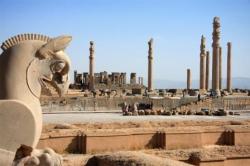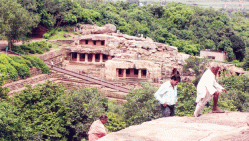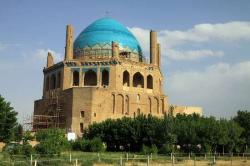INSTITUT SUPERIEUR D'ANTHROPOLOGIE
INSTITUTE OF ANTHROPOLOGY
ONLINE COURSES / COURS A DISTANCE
SPRING TERM : APRIL 2015
REGISTER NOW
IRAN –  Badoroud - An archeological site with an age of three millennia BC has been identified and undergone primary archeological examination in the city of Nataz, Isfahan Province. Head of the Cultural Heritage Department of Isfahan Hossein Yazdanmehr said according to a report by a group of fans of cultural heritage of Badoroud city field examination has been conducted in the area and on the basis of primary data the site dates back to three millennia BC (five thousand years ago) wherein remains of some recent eras are visible.He said preliminary studies show a high volume of surface remains such as clay works, tools such as clay trays for stripping grains, metal cutting device, and pottery baking and metal furnaces.Yazdanmehr said the clay works are mainly wheelwright and a number of them are imprinted in gray, crème and red.With regard to the evidence available and archeological studies which have been conducted expectations in the field of archeology can shed further light on the historical background of the region and prepare the ground for gaining access to architectural specifications and style of living of the inhabitants of the area.Badoroud area is rich in archeological and historical sites the study of which can lead to protection of valuable historical remains.Badoroud is a suburb of Natanz on the edge of the central desert of Iran in the north of Isfahan Province.
Badoroud - An archeological site with an age of three millennia BC has been identified and undergone primary archeological examination in the city of Nataz, Isfahan Province. Head of the Cultural Heritage Department of Isfahan Hossein Yazdanmehr said according to a report by a group of fans of cultural heritage of Badoroud city field examination has been conducted in the area and on the basis of primary data the site dates back to three millennia BC (five thousand years ago) wherein remains of some recent eras are visible.He said preliminary studies show a high volume of surface remains such as clay works, tools such as clay trays for stripping grains, metal cutting device, and pottery baking and metal furnaces.Yazdanmehr said the clay works are mainly wheelwright and a number of them are imprinted in gray, crème and red.With regard to the evidence available and archeological studies which have been conducted expectations in the field of archeology can shed further light on the historical background of the region and prepare the ground for gaining access to architectural specifications and style of living of the inhabitants of the area.Badoroud area is rich in archeological and historical sites the study of which can lead to protection of valuable historical remains.Badoroud is a suburb of Natanz on the edge of the central desert of Iran in the north of Isfahan Province.
http://www.irna.ir/en/News/81460029/?
INDE -Kozhikode - Director of Archaeology G. Prem Kumar on Friday sent an urgent fax message to District Collector C.A. Latha urging her to ensure the immediate stoppage of the renovation work on the centuries-old Tali Siva temple following allegations of ‘callous handling’ of archaeologically important rock carvings unearthed during the work.Work on replacing the old rock slabs ( Krishnashila ) around the Chuttambalam of the temple has been progressing for the past few days, under the aegis of the Tali Devaswom. The slabs, according to the temple authorities, were in bad shape and are being replaced with new granite slabs. Some of the old slabs, which were broken while being removed by unskilled workers, have prominent carvings on one side. These broken pieces with cracked images were found dumped on the wayside adjacent to the temple.Historian M.G.S. Narayanan said that these carvings, the pictures of which were emailed to him by friends, looked like from the medieval period and were definitely of archaeological significance. “The temple authorities are showing sheer callousness in treating them,” said Dr. Narayanan. He said that any structure which was more than 100 years old would be of archaeological significance. Any part of the Tali Temple, which he said was as old as the city of Kozhikode, with a history of more than 800 years, or more must be of archaeological importance. “The exact age and other features of the carvings can be assessed only after detailed examinations,” he said. The temple authorities, however, maintained that the pieces of rock carvings might not have any great archaeological significance.
http://www.thehindu.com/news/cities/kozhikode/historically-important-slabs-found-abandoned/article6774407.ece
INDE –  Khandagiri - The Khandagiri Anchalika Vikash Parishad has decided to approach the State Government next week for further excavation of the tunnel that was discovered near Khandagiri caves on Friday. Member of the Parishad and former Vice-Chancellor of Utkal University of Culture, Amiya Pattnaik said the tunnel was found one km away from the Khandagiri-Udaygiri caves during a construction work, but does not hold any similarity with the Jain style of architecture. “It is not a Jain cave and might have been constructed by the kings for self-protection or storing arms. It dates back to Second Century BC. The cave is above six-feet high and we believe that on further excavation, we might find a hall inside. A detailed study on the tunnel will throw more light,” he said. As the Archaeological Survey of India (ASI) in charge of the Khandagiri-Udaygiri caves, the State Government will have to ask the organisation to initiate excavation works. Khandagiri and Udayagiri were the centre of meditation for the saints during the reign of King Kharavela of Chedi dynasty during First Century BC.
Khandagiri - The Khandagiri Anchalika Vikash Parishad has decided to approach the State Government next week for further excavation of the tunnel that was discovered near Khandagiri caves on Friday. Member of the Parishad and former Vice-Chancellor of Utkal University of Culture, Amiya Pattnaik said the tunnel was found one km away from the Khandagiri-Udaygiri caves during a construction work, but does not hold any similarity with the Jain style of architecture. “It is not a Jain cave and might have been constructed by the kings for self-protection or storing arms. It dates back to Second Century BC. The cave is above six-feet high and we believe that on further excavation, we might find a hall inside. A detailed study on the tunnel will throw more light,” he said. As the Archaeological Survey of India (ASI) in charge of the Khandagiri-Udaygiri caves, the State Government will have to ask the organisation to initiate excavation works. Khandagiri and Udayagiri were the centre of meditation for the saints during the reign of King Kharavela of Chedi dynasty during First Century BC.
http://www.newindianexpress.com/states/odisha/Tunnel-Found-Near-Khandagiri-Caves/2015/01/11/article2614302.ece?
IRAN –  Soltanieh - Director of Soltanieh Dome Cultural Heritage Complex Ali Reza Razeqi told IRNA Saturday that Soltanieh was once capital of Ilkhanid Dynasty as well as a major city in Iran and the entire world. Given Soltanieh City's huge potentials, it has been proposed to be first archeological zone of the country, he said. Archeological and developmental operations in the city are currently being planned, which if implemented, it would witness bright prospects in terms of culture and development, he said. Located some 240 kilometers to the northwest of Tehran, Soltanieh used to be the capital of Mongol Ilkhanid rulers of in the 14th century. Its name translates as 'the Imperial'. In 2005, UNECO listed Soltanieh as one of the World Cultural heritage sites.
Soltanieh - Director of Soltanieh Dome Cultural Heritage Complex Ali Reza Razeqi told IRNA Saturday that Soltanieh was once capital of Ilkhanid Dynasty as well as a major city in Iran and the entire world. Given Soltanieh City's huge potentials, it has been proposed to be first archeological zone of the country, he said. Archeological and developmental operations in the city are currently being planned, which if implemented, it would witness bright prospects in terms of culture and development, he said. Located some 240 kilometers to the northwest of Tehran, Soltanieh used to be the capital of Mongol Ilkhanid rulers of in the 14th century. Its name translates as 'the Imperial'. In 2005, UNECO listed Soltanieh as one of the World Cultural heritage sites.
http://www.irna.ir/en/News/81459169/?
TURQUIE –  Urartu - Jewelry used by women and men in the Urartian era provide detailed information about social class differences, Van Yüzüncü Yıl University Head of Archaeology Department Associated Professor Rafet Çavuşoğlu has said. Artifacts and jewelry from the Urartian Kingdom 3,000 years ago, unearthed during excavations in the eastern province of Van, shed light on the mentality of life style and management of the era. Çavuşoğlu, who has been working on Urartian civilization for 21 years and examining these artifacts, said that as well as agriculture and stockbreeding, the Urartians were developed in metal embroidery, too. “The Urartians used jewelry such as rings, bracelets, earrings and etc. that we use today. But their use was different then. Jewelry showed class differences in Urartian culture. There are also differences between men’s jewelry with women’s,” he added.
Urartu - Jewelry used by women and men in the Urartian era provide detailed information about social class differences, Van Yüzüncü Yıl University Head of Archaeology Department Associated Professor Rafet Çavuşoğlu has said. Artifacts and jewelry from the Urartian Kingdom 3,000 years ago, unearthed during excavations in the eastern province of Van, shed light on the mentality of life style and management of the era. Çavuşoğlu, who has been working on Urartian civilization for 21 years and examining these artifacts, said that as well as agriculture and stockbreeding, the Urartians were developed in metal embroidery, too. “The Urartians used jewelry such as rings, bracelets, earrings and etc. that we use today. But their use was different then. Jewelry showed class differences in Urartian culture. There are also differences between men’s jewelry with women’s,” he added.
http://www.hurriyetdailynews.com/urartians-used-jewelry-according-to-status-.aspx?pageID=238&nID=76781&NewsCatID=375
ROYAUME UNI – Dunstable - Did the Romans finally defeat Queen Boudica and her rebel army in an enormous battle in Dunstable? The site where the two great armies met, and where thousands of Britons were killed, has never been traced and its whereabouts has long been a subject for research. Queen Boudica led a revolt against Roman rule in AD 60, during which her followers sacked Colchester, London and St Albans, slaughtering thousands of Romans. They then marched north up the Watling Street and were confronted by an army led by the Roman general Paulinus, who had hurried south when told of the rebellion. Although the Romans were heavily outnumbered, they achieved a great victory, killing (it is said) 80,000 Britons. No-one knows where the battle took place, but it could have been at the foot of Blow’s Downs, where Manshead School now stands. The only description of the battle was made by the Roman historian Tacitus, who indicated that Paulinus chose a defensive site in front of a plain, where his men were protected at the sides by wooded hills. The theory is that the mass of Britons were restricted and trapped in a narrowing pass in the Chilterns where they could not make use of their superior numbers.
http://www.dunstabletoday.co.uk/news/local-news/thousands-of-britons-killed-on-this-field-1-6514015